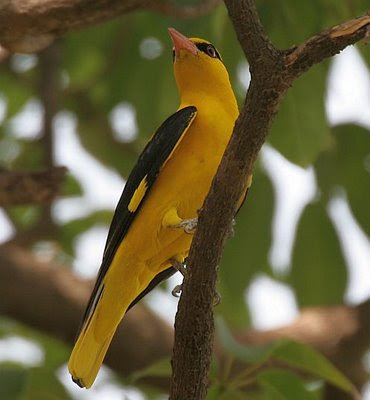This bird’s name, Oriole was first used in English in the 18th century, and comes from the Latin "aureolus" golden. This bird is known as the Golden Oriole or (Eurasian) Golden Oriole.
Its nesting season extends from April to July. It builds a cup-like nest of grass and fibres, bound with cobweb in the fork of a leafy twig tree. The bird lays 2 or 3 eggs, spotted black or reddish brown. Both sexes share all domestic duties.
Its nesting season extends from April to July. It builds a cup-like nest of grass and fibres, bound with cobweb in the fork of a leafy twig tree. The bird lays 2 or 3 eggs, spotted black or reddish brown. Both sexes share all domestic duties.




The Indian race Oriole (kundoo) differs from the European chiefly in that its black eye-streak extends behind the eye. The bird, which is the size of a Mynah, is bright golden with black in wings and tail, and a conspicuous black streak through the eye.

In the below photograph a female Oriole (kundoo) which is duller and greener than the male.
The kundoo is found singly or in pairs, among leafy trees in wooded country. The bird is found throughout India, excepting N.E. India and is not uncommon at Tiruvannamalai District.



